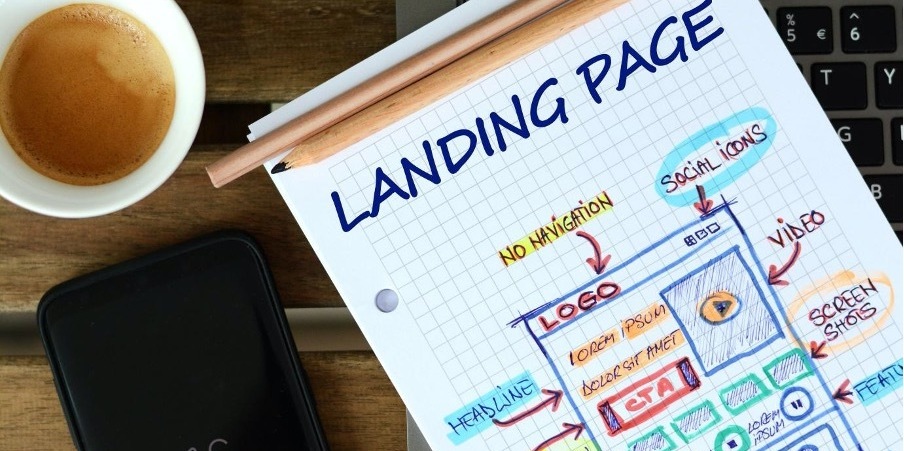Why Should I Have a Landing Page and How Do You Create It?
Posted on 5th April 2022
When people click on a link in an online ad, in an email, on social media or via another digital channel, the aim is for them to ‘land’ on a specific website page, hence the term ‘landing page’. That page is directly related to the reason why people click on the link; they want to find out more about the product or service that is being promoted.
Landing pages can significantly boost a business’s SEO optimisation but would you be surprised to know that 52% of links in B2B PPC ads point to the home page rather than a dedicated landing page?
Creating a landing page can make a significant difference to conversion rates. Indeed, 1 in 10 visitors is more likely to convert to a customer if they are directed to a landing page.
What does a landing page do for your business?

As well as being a great tool to boosting search engine optimisation (SEO) efforts, landing page benefits are multi-functional:
Strengthens online presence.
Increases brand awareness.
Builds trust and authenticity.
Optimises SEO.
Generates conversions.
Develops a strong customer base.
Whether it’s buying a promoted product, subscribing to a newsletter, downloading a white paper or responding to a special offer, the landing page has just one aim – to convert the visitor into a customer.
How to create a great landing page

The design of the landing page must keep the ultimate aim as its focus. Now’s the time when less is more; the simpler and clearer it is, the easier it is for the visitor to gather all the information they need to make a decision and hit the CTA (call to action) button. So, let’s look at how to create a great landing page.
A stand-out headline should state your proposition and meet the ‘why’ test. It should be big and bold, easy to read and catch the visitor’s attention immediately.
Always use a sub-headline on a landing page. It must complement the headline, not contradict, and introduce the visitor to your offering, be it a product/service, a newsletter, a special offer, an event invite or an ebook. It’s a short paragraph that not only defines your USP but also gives a brief overview of your proposition.
Showcase the benefits of your proposition that customers will get by using your product/service, subscribing to your newsletter or registering for an event. Use bullet points that are short, clear and answer your visitor’s queries.
Use images, graphics or videos to support and enhance your proposition to your visitor. A study by Venngage discovered that 80% of visitors to a landing page are more likely to convert to a customer when visual aids are used with text. It adds context and depth that the visitor can associate with your proposition.
Add social proof to your landing page, and we don’t mean icons to your social media pages – it’s quite likely they’ve come from there in the first place. Social proof, such as testimonials, reviews, statistics and numbers, certifications or memberships with industry organisations, authenticate your proposition and build trust with your audience. Research shows that landing pages incorporating social proof convert 12.5% more, on average, than landing pages that don’t.
The most important element of a landing page is the call to action. There’s no point persuading your visitor to take an action if you don’t provide them with the means to act. Use your CTA button more than once, too. Visitors will view your landing page up and down so add a CTA at the top, to the side and at the bottom so that no matter where they are on your landing page when they make their decision, the CTA button is right there. The label on your CTA button must clearly define the action you want them to take, such as Register, Subscribe, Watch or Download.
The content on the landing page must be compelling and persuasive, encouraging the visitor to act immediately. It should be clear, concise, on brand and relevant. Create a sense of urgency but answer their questions, too. For example, create a sense of urgency by telling them there is a limited time for the sale or promotion; make the CTA clear, simple and have the button right there.
Align your landing page’s branding and target message with that of your ad, be it PPC, social media or another. Not only are you sending out a consistent message, you are also pleasing Google.
The landing page needs to deliver value to the visitor. Define the benefits, i.e. what they will gain by taking action, and how your solution will solve their pain point. You may find that you need more than one landing page because visitors via social media will have a different level of awareness of your products/services than someone that has clicked your PPC ad from a Google search. Different landing pages can be designed to attract different audiences. Indeed, Hubspot’s research shows that businesses with 10-12 landing pages increased lead generation by 55%.
Don’t be tempted to add too much to your landing page. Visitors want to be able to read, view and digest the information quickly and clearly without having to scroll up and down the page. People tend to scan landing pages in an F-pattern; designing an attractive but clear and simple landing page following this pattern is more likely to keep the visitor engaged.
It is just one page, a snapshot of your proposition. Get it right and it’s probably one of the best lead generation tools in your marketing toolbox. Get it wrong and it could damage your business’s reputation. If you’re not confident about designing your landing page, ask us at It’seeze Windsor to help you.
It’seeze Windsor is a website design company that delivers professional web design and landing pages that deliver results. Not sure if your website is working for you? We offer a free Website Health Check that will determine the areas where improvements can be made. Call us today to create the website of your dreams and turn your business into a success. Contact us for more details.
We look forward to hearing from you.
Share this post:



